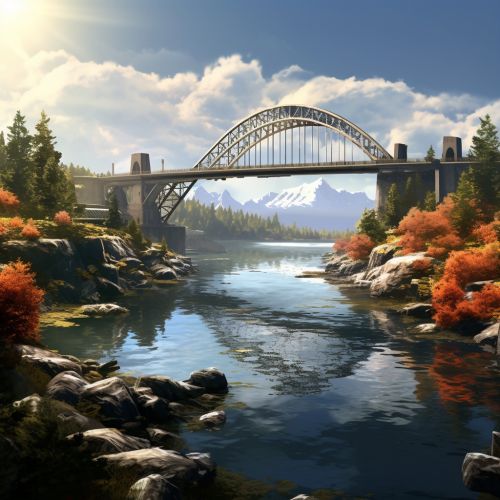Cantilever Bridge
Overview
A cantilever bridge is a type of bridge that is constructed using cantilevers, which are horizontal structures supported at only one end. The bridge is built by extending the cantilever sections from their supports towards each other, and then joining them with a central span. This method of construction allows for long, clear spans, such as those needed over a river or a valley.


Design and Construction
The design of a cantilever bridge involves a complex interplay of forces. The cantilever arms, or beams, are subjected to both bending and shear forces. The counterweight at the support of the cantilever arm provides the necessary balance to the system. This counterweight is often integrated into the design of the bridge as a whole, such as in the form of an approach span.
The construction of a cantilever bridge begins with the building of the piers, which are the vertical structures that support the bridge. These piers must be strong enough to withstand the weight of the bridge and any loads it carries, as well as environmental forces such as wind and water currents. Once the piers are in place, the cantilever arms are extended from them. These arms are typically built in sections, with each section added to the end of the previous one. This process continues until the arms reach their desired length.
The final step in the construction of a cantilever bridge is the joining of the cantilever arms with a central span. This span, also known as the suspended span, is often constructed separately and then lifted into place. Once the central span is secured, the bridge is complete.
Types of Cantilever Bridges
There are several types of cantilever bridges, each with its own unique design and construction methods. These include the simple cantilever bridge, the cantilever truss bridge, and the cantilever spar cable-stayed bridge.
A simple cantilever bridge consists of two cantilever arms extending from piers towards each other and meeting in the middle. The central span is relatively short in comparison to the length of the cantilever arms.
A cantilever truss bridge incorporates a truss, a structure made up of triangular units, into the design of the cantilever arms. The truss provides additional support and stability to the bridge, allowing for longer spans.
A cantilever spar cable-stayed bridge is a combination of a cantilever bridge and a cable-stayed bridge. In this design, cables run from the piers to the central span, providing additional support.
Notable Cantilever Bridges
There are many notable cantilever bridges around the world. These include the Forth Bridge in Scotland, the Quebec Bridge in Canada, and the Howrah Bridge in India.
The Forth Bridge, located in Scotland, is a cantilever railway bridge that spans the Firth of Forth. Completed in 1890, it was the first major structure in Britain to be constructed of steel.
The Quebec Bridge, located in Canada, is the world's longest cantilever bridge. It spans the Saint Lawrence River and was completed in 1917.
The Howrah Bridge, located in India, is one of the busiest bridges in the world. It spans the Hooghly River and carries a daily traffic of approximately 100,000 vehicles and 150,000 pedestrians.
Advantages and Disadvantages
Cantilever bridges offer several advantages. They can span long distances without the need for intermediate supports, making them ideal for situations where the central span needs to be free of obstructions, such as over a body of water. They are also relatively simple to construct, as they do not require falsework, or temporary supports.
However, cantilever bridges also have their disadvantages. They require large amounts of materials and are therefore often more expensive to build than other types of bridges. They also require strong foundations, as the forces exerted by the cantilever arms can be significant.
